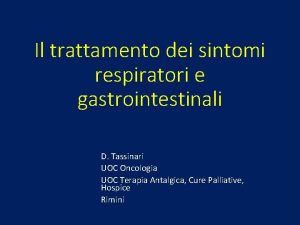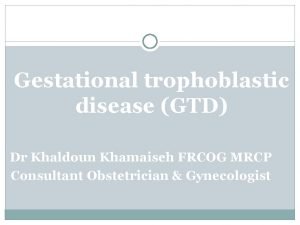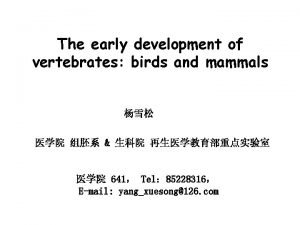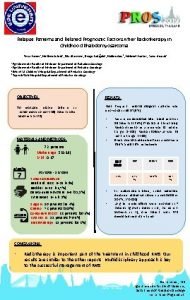Investigation of early prognostic factors in the development









- Slides: 9

Investigation of early prognostic factors in the development of early onset preeclampsia Nilay Karaca MD

Introduction To investigate whether complete blood count parameters of early pregnancy or biochemical markers of first trimester trisomy screening were related to prediction of early onset preeclampsia or not.

Material- Methods-1 The group 1 ( n=214) was composed from patients between 18 -40 year-old with a single pregnancy that diagnosed with preeclampsia at <34 th gestational weeks and had delivery at ≥ 37 th weeks of gestation. The group 2 ( n=240) was control. Excluding criteria: Getting pregnant by assisted reproductive technologies Having a body mass index (BMI) >30 kg/m 2 History of delivery complicated by chromosomal anomalies Current or previous medical problems Multiple pregnancies Patients who had vaginal bleeding at antenatal period History of preterm delivery

Material- Methods-2 Preeclampsia for a pregnancy is defined as having a systolic blood pressure ≥ 140 and diastolic blood pressure ≥ 90 as well proteinuria after 20 th gestational weeks Blood samples for complete blood count, PAPP-A and free beta-HCG were collected between 11+0 to 13+6 gestational weeks. The two groups were compared with each other due to their demographic features and obstetric and biochemical results.

Results The mean gestational weeks at delivery and birth-weight were significantly lower in group 1, comparing to group 2. NLR and PDW were found significantly higher in preeclampsia group comparing to control group. Lymphocyte count was significantly lower in preeclampsia group. PAPP-A was found lower in the same group .

Demographic and obstetric features of two groups Group 1 (n=214) Group 2(n=240) p-value Maternal age (years) Gravidity Smoking status Gestational weeks at delivery (weeks) BMI (kg/m 2) Birth weight (g) 28. 7± 3. 4 27. 5± 3. 5 0. 98 2(1 -3) 7 (3. 2%) 1(0 -2) 8 (3. 4%) 0. 13 0. 90 37. 6± 1. 1 40. 5± 1. 5 <0. 01 22. 9± 3. 2 2845± 334 22. 7± 3. 5 3320± 331 0. 09 <0. 01

Comparing two groups for hematological and biochemical markers Group 1 (n=214) Group 2 (n=240) p-value Leukocyte (x 103/mm 3) Leutrophil (x 103/mm 3) counts 8. 7± 1. 5 8. 5± 1. 4 0. 57 counts 6. 8± 2. 1 6. 6± 1. 4 0. 54 Lymphocyte (x 103/mm 3 ) counts 1. 8± 0. 49 2. 3± 0. 79 <0. 01 Platelet (x 103/mm 3 ) NLR counts 235± 53 238± 41 0. 13 3. 96± 1. 23 3. 22± 1. 24 0. 05 PLR 119± 51 120± 43 0. 87 MPV 10. 3± 0. 85 10. 4± 1. 1 0. 24 PCT 0. 251± 0. 04 0. 248± 0. 05 0. 77 PDW 12. 5± 2. 1 11. 6± 1. 87 <0. 01 PAPP-A (Mo. M) 0. 78± 0. 3 1. 19± 0. 84 <0. 01 free-b-HCG (Mo. M) 0. 99± 0. 51 1. 05± 0. 47 0. 36

Conclusion We found a strong relation between the high level of NLR and PDW as well low level of lymphocyte count and PAPP-A, with early onset preeclampsia development during the current pregnancy.

Thank you for your attention

















